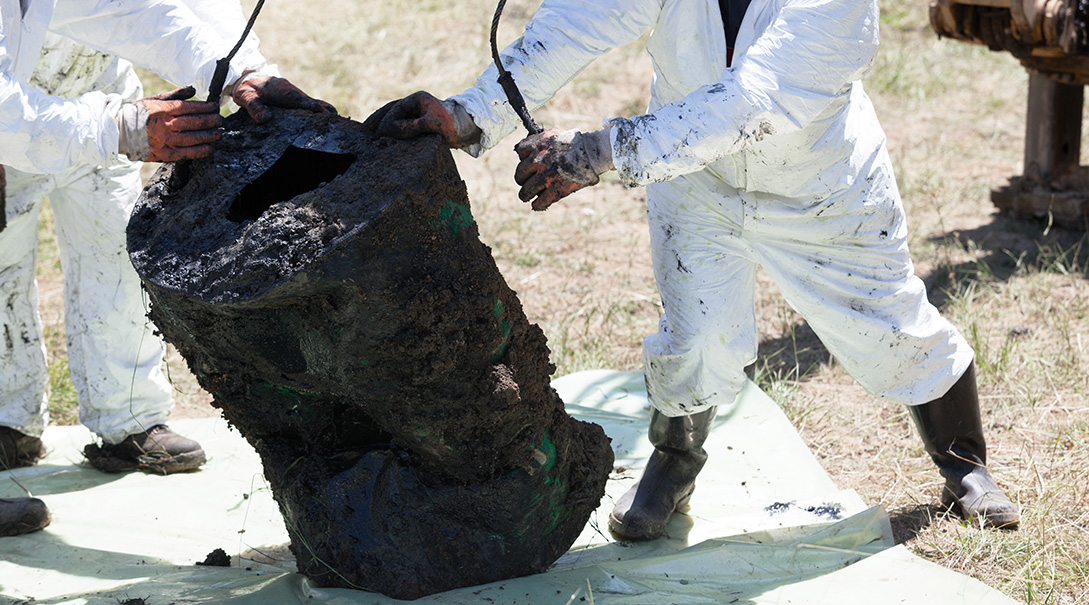While having an environmental issue at your worksite or workplace is troubling, a broad spectrum of contamination situations is treatable. There are two broad types of environmental remediation based on where treatment mechanisms are applied:
- Ex-situ – having the ground excavated and treated; and
- In-situ – treatment while the soil remains within the subsurface.
Table of Contents
Environmental Remediation 101: What Your Business Needs to Know
Environmental remediation refers to the process of removing contaminants or pollutants from soil, water, and other environmental media. This process helps to protect the environment and public health by reducing the presence of hazardous substances.
If your business is facing environmental issues, hiring an environmental remediation company can help you address these problems effectively. Environmental remediation is relevant to various industries, and your business should be aware of many types of environmental remediation.
Here are a few types of environmental remediation that your business needs to know about:
- Soil Remediation
- Water Remediation
- Air Remediation
- Contaminated Site Remediation
- Groundwater Remediation
- Bioremediation
- Oil Spill Cleanup
- Hazardous Waste Management
- PCB Remediation
- Mercury Remediation
- Asbestos Abatement
- Lead Paint Removal
- Mold Remediation
- Radon Remediation
- Vapor Intrusion Remediation
- In-Situ Remediation
- Ex-situ Remediation
- Thermal Remediation
- Chemical Oxidation Remediation
- Carbon Absorption Remediation
- Landfill Remediation
- Sediment Remediation
- Brownfield Redevelopment
- Green Remediation
- Sustainable Remediation
Each of these types of environmental remediation addresses a different environmental challenge, and the specific remediation method used will depend on the type and extent of the contamination.
By understanding the types of remediation that are available, businesses can better navigate environmental challenges and avoid potential environmental damage. Hiring an environmental remediation company is a smart investment for businesses that want to address environmental issues proactively and effectively. An environmental remediation company can help you navigate complex environmental regulations, stay in compliance, and avoid penalties.
In addition to avoiding fines and regulatory violations, there are many benefits to hiring an environmental remediation company. By demonstrating a commitment to environmental stewardship, your business can enhance its reputation and make it more attractive to customers and investors. Taking a proactive approach to environmental remediation can also save your business money in the long run by avoiding costly cleanup efforts and regulatory fines.
Don’t let environmental issues become a threat to your business. By understanding the types of environmental remediation available and working with an experienced environmental remediation company, you can protect the environment, public health, and your business’s reputation.
Types of environmental remediation techniques
While you can think of ex-situ and in-situ technologies as two types of environmental remediation techniques, those are categories. There are dozens of specific types of environmental remediation techniques, as you can see in this abridged list:
#1. Activated carbon-based technology
In situ soil and groundwater remediation requires a method that introduces activated carbon (AC)-based amendments. Amendments commonly used include bioremediation, in situ chemical oxidation (ISCO), and in situ chemical reduction (ISCR).
Key Takeaway: Activated carbon plays a crucial role in both soil and groundwater remediation by facilitating different treatment approaches.
#2. Bioreactors
Biological processes are used to remediate groundwater via this in-situ form of remediation.
Key Takeaway: Bioreactors harness natural biological processes to purify groundwater.
#3. Biowall
Another one of the natural types of environmental remediation, this permeable reactive barrier (PRB), is an in-situ method that treats groundwater using biological processes. (See below for more information.)
Key Takeaway: The Biowall leverages biology to remove contaminants from groundwater effectively, serving as a natural, permeable barrier.
#4. Bioremediation – cometabolic
In a quest for carbon and energy, microbes reduce and oxidize metabolites. In the process, a cofactor or enzyme is created, which is leveraged for decontamination through cometabolic bioremediation.
Key Takeaway: Microbes play a significant role in cometabolic bioremediation, turning harmful pollutants into less harmful substances.
#5. Electrokinetic-enhanced remediation
This form of environmental remediation introduces an electrical current to remove contaminants by stimulating ions to move within the subsurface.
Key Takeaway: Electrokinetic remediation utilizes electrical currents for contaminant removal, driving ions and pollutants from the soil.
#6. Environmental dredging
If there is sediment beneath the contaminated water, you can remove it, treat it, and/or move it elsewhere through environmental dredging.
Key Takeaway: Environmental dredging is a powerful tool for cleaning up water bodies with contaminated sediment.
#7. Environmental fracturing
This form of environmental remediation is often used to increase the efficiency of soil vapor extraction (SVE), in situ bioremediation, in situ chemical oxidation/reduction (ISCO/ISCR), pump & treat (P&T), and other primary technologies. Environmental fracturing creates or expands openings in soil or bedrock to enhance groundwater andsoil cleanup effectiveness.
Key Takeaway: Environmental fracturing improves the effectiveness of other remediation technologies by enhancing permeability in the subsurface.
#8. Excavation and off-site disposal
Off-site, permitted disposal facilities can take care of contaminated material if you transport it to them.
Key Takeaway: Excavation and off-site disposal provide a safe and effective means of dealing with contaminated material.
 #9. Groundwater circulating wells
#9. Groundwater circulating wells
A circulation pattern is introduced to groundwater for this subsurface remediation method. Groundwater passes through a screened section into a well. After that, it is pumped into another screened section and then reenters the aquifer.
Key Takeaway: Groundwater circulating wells utilize circulation patterns to remediate contaminated groundwater within the subsurface.
#10. Groundwater pump & treat
This technique starts by pumping contaminated non-aqueous phase liquid (NAPL) or groundwater out of the subsurface. Above ground, it is treated and then discharged.
Key Takeaway: The groundwater pump & treat technique is a two-step process involving pumping contaminants from the subsurface and treating them above ground.
#11. Horizontal remediation wells (HRWs)
Using horizontal directional drilling (HDD), horizontal remediation wells (HRWs) are set up underground at a shallow angle or parallel to the ground surface. Obstructions at the surface may make it difficult for vertical wells to access relevant areas, so HRWs can be useful.
Key Takeaway: HRWs offer a solution for challenging terrain where surface obstructions limit access to contaminated areas.
#12. In situ chemical reduction (ISCR)
You may want to degrade metallic oxyanions, use precipitation or adsorption to immobilize metals or degrade toxic organic compounds to less toxic compounds. This in situ method achieves those ends by introducing reductants or reductant-generating materials.
Key Takeaway: ISCR is an effective in situ remediation method for reducing the toxicity of various contaminants.
#13. In situ flushing
One of the more straightforward types of environmental remediation, in situ flushing, is conducted by injecting a liquid solution or water into a contaminated area. It uses flooding to decontaminate.
Key Takeaway: In situ flushing uses water or liquid solutions to effectively “rinse” contaminants from soil.
#14. In situ chemical oxidation (ISCO)
This process generally uses redox (reduction/oxidation) reactions to chemically convert hazardous compounds to less toxic or nontoxic ones. Hydrogen peroxide and ozone are examples of oxidizing agents.
Key Takeaway: ISCO utilizes redox reactions for the chemical transformation of hazardous compounds into safer ones.
#15. In situ pH control
If you have groundwater or soil that has a low or high pH, you can use this in situ method to neutralize it.
Key Takeaway: In situ pH control adjusts the acidity or alkalinity of soil or groundwater to enhance the effectiveness of remediation.
#16. Landfill and soil capping
Sometimes separation is powerful. These containment methods separate the ground surface from a contamination source area or waste body by creating a barrier.
Key Takeaway: Landfill and soil capping serve as a containment strategy to limit the spread of contamination.
#17. Monitored natural recovery (MNR) and enhanced monitored natural recovery (EMNR)
These two approaches are used to remedy sediment contamination. They are often used in conjunction with amendments, sediment capping, dredging, or other technologies.
Key Takeaway: MNR and EMNR techniques leverage natural recovery processes, often enhanced with other technologies, to remediate sediment contamination.
#18. Monitored natural attenuation (MNA)
This method meets remediation objectives by reducing the concentration of a contaminant. It uses biological, chemical, and physical processes naturally occurring in situ.
Key Takeaway: MNA is a remediation approach that relies on natural processes to reduce the concentration of contaminants.
#19. Multi-phase extraction (MPE)
You can target problematic groundwater, vapor, and light non-aqueous phase liquid (LNAPL) through MPE. This technology can remove any of those three at the same time.
Key Takeaway: MPE is a versatile remediation technique used for the simultaneous removal of different types of contaminants.
#20. Permeable reactive barrier (PRB)
By blending subsurface management of fluid flow with a passive biological or chemical treatment zone, you can rid groundwater of its dissolved-phase contaminants using a PRB. A dissolved contaminant plume is treated as it flows through this in situ technology.
Key Takeaway: PRB is an in-situ technology that effectively treats dissolved contaminant plumes in groundwater.
#21. Phytotechnologies
You can remediate contaminants in groundwater, surface water, sediment, or soil with vegetation. Capable of clearing away, destroying, stabilizing, containing, or moving contamination, these six plant mechanisms empower phytotechnologies:
- Phytodegradation
- Phytoextraction
- Phytohydraulics
- Phytosequestration
- Phytovolatilization
- Rhizodegradation.
Key Takeaway: Phytotechnologies use various plant mechanisms to manage and remediate environmental contamination.
#22. Soil vapor extraction (SVE)
Typically performed in situ (but sometimes ex-situ), it rids unsaturated (vadose) zone soil of organic contaminants that are volatile and semivolatile. The technology works by inducing controlled airflow with a vacuum.
Key Takeaway: SVE is a remediation technology designed to remove volatile organic contaminants from unsaturated soils.
#23. Soil washing
Based on particle size, a water-based system separates bulk soil from contaminants attached to fine soil particles. To aid in removing heavy metals and organics, you can adjust the pH of the wash water. Additionally, you can augment it with a chelating agent, surfactant, or basic leaching agent.
Key Takeaway: Soil washing is a remediation process that uses water and additives to remove contaminants from soil based on particle size.
#24. Solidification/stabilization (S/S)
Solidification reduces the surface area vulnerable to leaching by reducing contaminant migration. The process either forms a coating over waste or creates a solid material that encapsulates it. Stabilization makes it more difficult for waste to leach by reducing solubility or immobilizing hazardous substances.
Key Takeaway: S/S methods aim to reduce contaminant mobility and leachability to achieve environmental remediation.
#25. Solvent extraction
Soil can be separated from metal or organic contaminants by performing extraction with an organic solvent. The technology uses an extraction unit to blend contaminated soil and the solvent. The resulting solution is then sent through a separator.
Key Takeaway: Solvent extraction is a remediation process that separates contaminants from soil using an organic solvent.
The Role Of Environmental Remediation Services
As you can see, dozens of environmental remediation techniques can be used to clean up a site. At AOTC, we’re problem-solvers. We know exactly what environmental remediation method will be most effective for your situation and keep you environmentally compliant. We implement proactive and cost-effective remedies to help fast-track your project. Discover how our environmental remediation services can help you.


 #9. Groundwater circulating wells
#9. Groundwater circulating wells